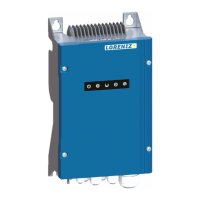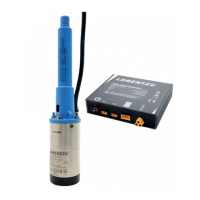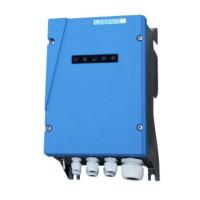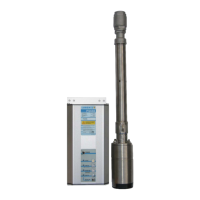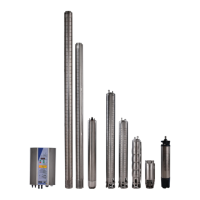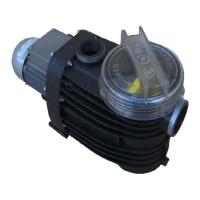Pressurizing Systems4.12
LORENTZ PS pump systems are excellent for
automatic water pressurizing when powered by a
battery system. If you are raising water vertically AND
pressurizing, the pump must handle to total head. Note the
relationship: 2.31 ft = 1 PSI (1 bar = 10 m vertical) Example:
A pump that lifts 100 ft (30m) vertical and pressurizes to
60 PSI (4 bar) must pump the equivalent of 240 ft (70 m).
Be sure your pump was chosen correctly for your applica-
tion. The installation is similar to that of a conventional AC
pump.
A typical pressurizing control assembly is illustrated
in the following photo. These are standard components,
same as used for conventional AC water pressure systems.
The parts (from left to right) are:
check valve (prevents back-flow)1.
pressure gauge 0-100 PSI (0-7 bar)2.
pressure relief valve 753. PSI (5.3 bar)
tank tee (a bronze casting that holds all the com-4.
ponents)
pressure switch (turns the pump on/off according to 5.
pressure set-points, adjustable)
hose outlet (to drain the system or to supply water 6.
when outlet is shut off)
ball valve (to shut off the supply to the outlets)7.
The components can be purchased from local suppliers, or
as a kit from your pump supplier.
Pressure tank A pressure tank is required. We recom-
mend a captive-air pressure tank of 40 US Gal. (150 l) OR
MORE, to assure a steady supply of water pressure as the
pump cycles on and off and the water demand varies. A
large tank is always best. Size and cost are the only practi-
cal limitations. More than one tank can be used to increase
the total capacity.
How to pre-charge a captive-air pressure tank for
PS pump systems For the system to function properly,
the air bladder in the tank must be pre-charged with air
according to these instructions.
Make note of the cut-in setting of the pressure 1.
switch (either by observation or knowing the factory
setting).
Turn off the pump and exhaust the water from the 2.
tank if necessary, so the water pressure is 0.
Find the air fitting on top of the tank. Measure the 3.
air pressure in the tank using a tire gauge.
Adjust the pressure to about 3 PSI (0.2 bar) LESS 4.
THAN THE CUT-IN PRESSURE.
Pressure switch PS pumps systems can use an ordinary
pressure switch sold for conventional AC pumps. Do not
use a pressure switch with “low water cutout” or “loss
of prime” feature (with a shutoff lever on the side). It is
intended to prevent dry run of centrifugal pumps. The heli-
cal rotor pump types will maintain pressure even as it runs
dry, so this device will not work reliably. It will also shutoff
if the pressure falls due to high water demand.
Pressure switch connection There are two ways to con-
nect the pressure switch:
primary power switching1. The switch is used to
disconnect the DC power source. Wire the switch
between the power source distribution point and the
controller, as you would with a conventional pump.
remote switching2. This method uses the “remote
float switch” terminals. Small wire (minimum #18
AWG / 1 mm
2
) can be run to the pressure switch from
a long distance. See illustration below. Advantage:
the controller stays on all the time. If the water
source runs low (even if it recovers) the “Source
Low” indicator light will stay on to notify the user.
Power draw of the controller in OFF mode is only
about 1 watt.
WARNING A PRESSURE RELIEF VALVE
IS REQUIRED. If the pressure switch
fails, this will prevent extreme
pressure from bursting the tank or
piping and causing a flood. Install the valve near
the pressure tank, before the shutoff valve. Use a
1/2 in (or larger) valve set about 25 – 75 % higher
than the cut-out pressure. Run a pipe or hose from
its outlet to a drain or to the outdoors where water
discharge will not cause damage.
Wiring for pressure switchFigure 13:
pressure switchpressure gauge
to pressure
tank
WATER IN
from pump
WATER OUT
to distribution
system
check valve hose outlet tank tee
Typical assembly for Figure 14:
automatic water pressurising
